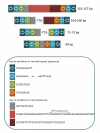Comparative analysis of two Neisseria gonorrhoeae genome sequences reveals evidence of mobilization of Correia Repeat Enclosed Elements and their role in regulation
- PMID: 19203353
- PMCID: PMC2649163
- DOI: 10.1186/1471-2164-10-70
Comparative analysis of two Neisseria gonorrhoeae genome sequences reveals evidence of mobilization of Correia Repeat Enclosed Elements and their role in regulation
Abstract
Background: The Correia Repeat Enclosed Element (CREE) of the Neisseria spp., with its inverted repeat and conserved core structure, can generate a promoter sequence at either or both ends, can bind IHF, and can bind RNase III and either be cleaved by it or protected by it. As such, the presence of this element can directly control the expression of adjacent genes. Previous work has shown differences in regulation of gene expression between neisserial strains and species due to the presence of a CREE. These interruptions perhaps remove the expression of CREE-associated genes from ancestral neisserial regulatory networks.
Results: Analysis of the chromosomal locations of the CREE in Neisseria gonorrhoeae strain FA1090 and N. gonorrhoeae strain NCCP11945 has revealed that most of the over 120 copies of the element are conserved in location between these genome sequences. However, there are some notable exceptions, including differences in the presence and sequence of CREE 5' of copies of the opacity protein gene opa, differences in the potential to bind IHF, and differences in the potential to be cleaved by RNase III.
Conclusion: The presence of CREE insertions in one strain relative to the other, CREE within a prophage region, and CREE disrupting coding sequences, provide strong evidence of mobility of this element in N. gonorrhoeae. Due to the previously demonstrated role of these elements in altering transcriptional control and the findings from comparing the two gonococcal genome sequences, it is suggested that regulatory differences orchestrated by CREE contribute to the differences between strains and also between the closely related yet clinically distinct species N. gonorrhoeae, Neisseria meningitidis, and Neisseria lactamica.
Figures




Similar articles
-
Genome analysis and strain comparison of correia repeats and correia repeat-enclosed elements in pathogenic Neisseria.J Bacteriol. 2002 Nov;184(22):6163-73. doi: 10.1128/JB.184.22.6163-6173.2002. J Bacteriol. 2002. PMID: 12399486 Free PMC article.
-
Neisserial Correia repeat-enclosed elements do not influence the transcription of pil genes in Neisseria gonorrhoeae and Neisseria meningitidis.J Bacteriol. 2011 Oct;193(20):5728-36. doi: 10.1128/JB.05526-11. Epub 2011 Aug 19. J Bacteriol. 2011. PMID: 21856854 Free PMC article.
-
Inversion of Correia repeat enclosed elements in Neisseria gonorrhoeae.Microbiology (Reading). 2017 Jan;163(1):31-36. doi: 10.1099/mic.0.000394. Microbiology (Reading). 2017. PMID: 27902415
-
Comparative overview of the genomic and genetic differences between the pathogenic Neisseria strains and species.Plasmid. 2005 Nov;54(3):191-218. doi: 10.1016/j.plasmid.2005.04.005. Epub 2005 Jul 15. Plasmid. 2005. PMID: 16024078 Review.
-
Mobile genetic elements in Neisseria gonorrhoeae: movement for change.Pathog Dis. 2017 Aug 31;75(6). doi: 10.1093/femspd/ftx071. Pathog Dis. 2017. PMID: 28645177 Review.
Cited by
-
DNA uptake sequences in Neisseria gonorrhoeae as intrinsic transcriptional terminators and markers of horizontal gene transfer.Microb Genom. 2016 Aug 25;2(8):e000069. doi: 10.1099/mgen.0.000069. eCollection 2016 Aug. Microb Genom. 2016. PMID: 28348864 Free PMC article.
-
Diversity of the type VI secretion systems in the Neisseria spp.Microb Genom. 2023 Apr;9(4):mgen000986. doi: 10.1099/mgen.0.000986. Microb Genom. 2023. PMID: 37052605 Free PMC article.
-
Correia Repeat Enclosed Elements and Non-Coding RNAs in the Neisseria Species.Microorganisms. 2016 Aug 25;4(3):31. doi: 10.3390/microorganisms4030031. Microorganisms. 2016. PMID: 27681925 Free PMC article.
-
Impact of small repeat sequences on bacterial genome evolution.Genome Biol Evol. 2011;3:959-73. doi: 10.1093/gbe/evr077. Epub 2011 Jul 29. Genome Biol Evol. 2011. PMID: 21803768 Free PMC article.
-
A phylogenetic method to perform genome-wide association studies in microbes that accounts for population structure and recombination.PLoS Comput Biol. 2018 Feb 5;14(2):e1005958. doi: 10.1371/journal.pcbi.1005958. eCollection 2018 Feb. PLoS Comput Biol. 2018. PMID: 29401456 Free PMC article.
References
-
- Correia FF, Inouye S, Inouye M. A family of small repeated elements with some transposon-like properties in the genome of Neisseria gonorrhoeae. J Biol Chem. 1988;263:12194–12198. - PubMed
Publication types
MeSH terms
Substances
LinkOut - more resources
Full Text Sources
Research Materials
Miscellaneous

